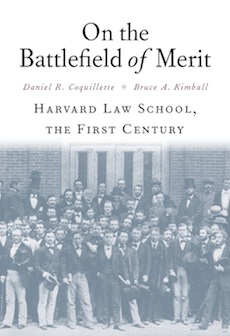By Allen D. Boyer
On May 14, 1817, the Harvard University Corporation voted to establish “a school for the instruction of students at law, at Cambridge, under the patronage of the university.” As a bicentennial commemoration of this event—a milestone in the history of American education and a turning-point in the history of American law—Daniel Coquillette and Roger Kimball have published a history of Harvard Law School’s first century. There have been earlier histories of the institution; this is the first to give the school the close, documented scrutiny that it deserves.
The idea that law might be taught in an academic setting took decades to triumph. American lawyers had learned by reading and apprenticeship. (At the first American law school, run by Judge Tapping Reeve in upcountry Connecticut, instruction resembled modern-day bar review lectures.) Harvard Law School weathered a crisis in the late 1820s and began to ascend when Joseph Story, still serving as an associate justice of the United States Supreme Court, became Dane Professor of Law in 1829.
After Story’s arrival, to those who know law schools, the story becomes oddly familiar. It features superstar faculty (the school survived because of Story’s ability and prestige) and academic rivalries (faculty members took different sides in the great Charles River Bridge case). Attendance figures, tuition charges, faculty salaries, and finances are worked out in detail—as are marketing costs, for the advertisements that the school placed in newspapers as far south as Washington. (Behind this, one suspects, is the experience of Coquillette, a long-serving law school dean.)
In 1870, the narrative is jolted by the arrival of an unlikely hero: a crabbed, dogged, formidably bearded, and literally myopic man, Christopher Columbus Langdell. As the law school’s first dean, he led an educational revolution that Kimball has studied. Langdell came from hardscrabble New Hampshire. He had worked as a mill-hand in his youth, before reaching Harvard, where he found sanctuary in the law and the law library. He was a “pauper scholar” but a brilliant one. He returned to Cambridge from Wall Street, disgusted by the shenanigans of Gilded Age legal practice, a believer in the idea of law as science and principle.
To American law, Langdell contributed the casebook, the Socratic method, the first-year Contracts course, the hypothetical-case exam question, standards and selectivity in law-school admissions, and rigor in grading. He made the law school a graduate-level institution and divided the curriculum into first-year and upper-level courses. He doubted that law professors should be practitioners. Student notes allow some of Langdell’s classes to be reconstructed with stenographic precision; the transcript shows give-and-take discussion like that of the modern classroom.
Throughout this history, educators struggle with eternal problems: revenues, endowments, appointments, curriculum, and facilities. What connects the history of Harvard Law School to the broader course of American history is the changing parade of the student body. Of its antebellum alumni, more than two hundred fight for the Confederacy. The first black students appear, making their marks as orators or football standouts, nine prior to 1910, alongside Chinese from Hawaii and visitors from Meiji Japan. The faculty debates whether to admit women, divides, and declines. To raise admissions standards, the law school limits admission to students holding “respectable” degrees—but of the 108 colleges on the first list of acceptable schools, no Roman Catholic colleges are included.
Ironically, this book ends as a cliff-hanger. By 1906, out of student tuition, the law school had built up a cash reserve of $498,000. To honor its great dean, the school began construction of Langdell Hall, an edifice that would not be fully completed until 1929. In 1910, the incoming dean, Ezra Ripley Thayer, found that construction costs had depleted the cash reserve; only $31,660 remained. “The Harvard Law School,” Thayer warned the alumni, “cannot keep its present position by resting upon its past achievements.” This sounds hortatory and unexceptionable—it is what deans commonly say. Heard in historical context, it has an undertone of quiet financial alarm.
In 1967, Arthur Sutherland published a sesquicentennial history, The Law at Harvard: A History of Ideas and Men. The title was obtuse and has been roundly mocked. As well as ideas and personalities, this history deals with ways and means. (Causes and controversies, the lawyer’s stock in trade, may dominate a forthcoming volume on the history of the twentieth-century law school.) This befits a law school where Langdell saw law as science and principle but taught his students to grapple with realities.
Both authors are Phi Beta Kappa members. Daniel R. Coquillette was inducted at Williams College in 1965.
Allen D. Boyer (ΦBK, Vanderbilt University, 1977) is a lawyer and writer in New York City. Vanderbilt University is home to the Alpha of Tennessee Chapter of Phi Beta Kappa.




